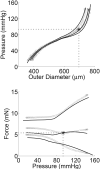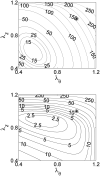A microstructurally motivated model of arterial wall mechanics with mechanobiological implications
- PMID: 24197802
- PMCID: PMC3943530
- DOI: 10.1007/s10439-013-0928-x
A microstructurally motivated model of arterial wall mechanics with mechanobiological implications
Abstract
Through mechanobiological control of the extracellular matrix, and hence local stiffness, smooth muscle cells of the media and fibroblasts of the adventitia play important roles in arterial homeostasis, including adaptations to altered hemodynamics, injury, and disease. We present a new approach to model arterial wall mechanics that seeks to define better the mechanical environments of the media and adventitia while avoiding the common prescription of a traction-free reference configuration. Specifically, we employ the concept of constituent-specific deposition stretches from the growth and remodeling literature and define a homeostatic state at physiologic pressure and axial stretch that serves as a convenient biologically and clinically relevant reference configuration. Information from histology and multiphoton imaging is then used to prescribe structurally motivated constitutive relations for a bi-layered model of the wall. The utility of this approach is demonstrated by describing in vitro measured biaxial pressure-diameter and axial force-length responses of murine carotid arteries and predicting the associated intact and radially cut traction-free configurations. The latter provides a unique validation while confirming that this constrained mixture approach naturally recovers estimates of residual stresses, which are fundamental to wall mechanics, without the usual need to prescribe an opening angle that is only defined conveniently on cylindrical geometries and cannot be measured in vivo. Among other findings, the model suggests that medial and adventitial stresses can be nearly uniform at physiologic loads, albeit at separate levels, and that the adventitia bears increasingly more load at supra-physiologic pressures while protecting the media from excessive stresses.
Figures







References
-
- Agianniotis A, Rachev A, Stergiopulos N. Active axial stress in mouse aorta. J. Biomech. 2012;45:1924–7. - PubMed
-
- Brankov G, Rachev I, Stoychev S. “Mechanics of biological solid. In: G. Brankov., editor. Proceedings of the Euromech Colloquium. Bulgarian Academy of Sciences; Varna, Bulgaria: 1975. pp. 71–78.
Publication types
MeSH terms
Grants and funding
LinkOut - more resources
Full Text Sources
Other Literature Sources

